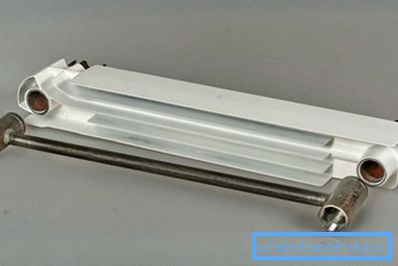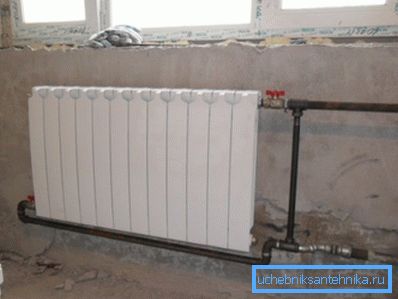Heat dissipation of bimetallic radiators: device devices,
Both radiators, both aluminum and bimetallic, have an external similarity. The difference can only be recognized by holding them in the hands, the second weighs an order of magnitude more, which is explained by its device - steel tubes are located inside the heater, thanks to which the radiator is allowed to be used in the central heating network. About this, as well as the heat transfer device and talk below.

Device
Why did you need such constructive additions to the aluminum radiator? After all, the heat transfer of this metal is much more steel, respectively, in an apartment with aluminum heating devices will be noticeably warmer.

But the fact is that aluminum has "weak points", and above all, is associated with the quality of the coolant used for urban heating networks. The heat carrier used carries with it various impurities, including alkalis and acids, which destroy aluminum.
The second important point is the inability to withstand the hydraulic pressure, which is not uncommon for houses connected to the central heating system.
Properties
The following facts speak in favor of bimetallic heating devices:
| Chemical resistance | In bimetallic structures, coolant circulates through steel tubes without contact with aluminum. |
| Strength | Bimetallic radiator is able to withstand pressure from 30 to 40 bar, which completely eliminates the possibility of destruction from water hammer. |
| Durability | Manufacturers of these heaters guarantee their long work. On average, the service life is set at 20 years. |

Thus, in bimetallic radiators all positive qualities of aluminum devices are preserved.
They possess:
- high heat emission;
- attractive appearance;
- good compactness.
Taking into account their design features, it is possible to assert with confidence that they will become an ideal choice when installing a heating system in urban apartments with their own hands.

Heat transfer and connection method
The correct number of radiator sections for a particular room is only half the work. The rest is to find the best way to connect the heater, so that it can fully show its qualities. So, it is necessary to choose from such options:
| Unilateral direct | The best way to connect not only the bimetallic radiator, but any other. This indicator of heat transfer you can see in the passport of the device. In this case, the coolant enters the radiator from above, completely passes through all its sections and leaves on the same side from below. |
| Diagonal | A good option and fully justified only for batteries with a large number of sections, namely - > 12 pieces The heated water enters the device from one side above, passes through the channels and exits through the lower radiator outlet on the other side. In this case, you will be able to minimize possible heat loss and achieve the desired result. |
| Bottom | It is used when the heating system pipeline is hidden in the floor. Connection instructions are as follows: the input is from one side into the lower opening of the device, the output is from the lower opening from the other side. Experience shows that in this case you will have to add a section, since the heat loss will be within 10%. |
| Single tube | This connection is a serial connection of radiators. At the same time, heat losses can reach 40%, therefore, we do not recommend using it in autonomous heating systems, otherwise the price of heat will be too high. |

It can be concluded that:
- if you want to achieve maximum heat transfer from heaters with a standard number of sections 7-10, it is necessary to be guided by their direct one-way connection to central heating;
- in the case when the area of the room is large enough and it is required to install radiators with the number of sections exceeding 12, diagonal switching of the device in a two-pipe system will be suitable (feed + return).

Correct installation site
Another important question that we often forget about, considering that it’s not so significant. The classic version is under the window, but why?
This is due to the access of cold air to the room:
- through the window it enters much more than through the outer walls;
- he immediately goes down and begins to climb along the floor, causing discomfort and a desire to rise higher.
Therefore, you need to put a thermal barrier that will allow to dilute or even completely negate the cold flow.
Tip: use a radiator with a width of 70-90% of the window opening, then the air coming in from the street will immediately warm up.
There are also certain installation rules that must be followed in order to create good convection and thereby improve heat transfer:
- leave a gap of 60 mm or more between the heater and the floor;
- from the window sill, the distance to the upper part of the radiator should be almost the same - 50-60 mm or more;
- from the wall should retreat 25 mm or more.

We also recommend:
- in the corner room with an additional external wall, to reduce heat losses, install another device on the cold wall. Its main task will be to compensate for power, and the height of the installation does not matter, take as a model the level of batteries installed under the window openings;
- Before installing radiators, calculate the number of sections so that the heat output is sufficient, taking into account losses through walls and windows.
Tip: to increase heat transfer, install a foil-screened foil screen behind the device, with the metal side inside the room.
Conclusion
Normal heat dissipation of heaters allows not only to obtain the necessary heat in the room, but even really save. Bimetallic radiators are powerful instruments capable of quickly and efficiently heating residential and commercial premises when properly connected and installed. The video in this article will provide an opportunity to find additional information on the above topic.